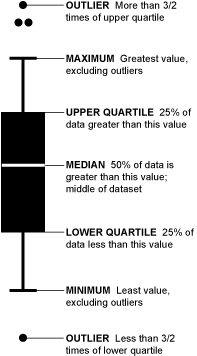The Box Plot
Contents
Creating a box and whisker plot using SPSS
(Refer to emailed file for screen-shots and further assistance)
1) Open SPSS and EXCEL
2) Copy the data (into SPSS) that you would like to use. For example, test scores disaggregated by gender. Make sure that you assign numbers to gender (In example below: 1 = male; 2 = female).
3) Once data is entered into SPSS (as depicted above), click on: “Graphs boxplot”
4) Click “define” (with “simple” & “summary for groups of cases” chosen)
5) Move “test” (or your variable of choice) into the variable section
6) Move “gender” (or whatever you choose) into the “category axis” section.
7) Click OK.
8) In order to format in APA, double click on the graph in SPSS. Change each axis to read what you would like them to read.
9) Close the “chart editor” and copy and paste your final graph from SPSS into your document of choice.
10) Have a drink to congratulate yourself on a job well done. Please note: this step is not in the latest version of APA).
contributed by Chris Longo
What is a Box Plot and When is It Used
The box plot or box-and-whisker plot is a graphic, created by John W. Tukey, used to show the distribution of a set of data. It is frequently used with data that can also be represented with a histogram, but the box plot shows more information than a standard histogram. For example, the box plot is useful to researchers because it shows extreme scores.
How to Read a Box Plot
Let's say we ask 282 people how many pairs of shoes they've consumed in the past ten years. We'll sort those responses from least to greatest and then graph them with our box-and-whisker. See the example above.
Take the top 50% of the group (142) who bought more pairs of shoes; they are represented by everything above the median (the white line). Those in the top 25% of shoe buying (71) are shown by the top "whisker" and dots. Dots represent those who bought a lot more shoes than normal or a lot less than normal (outliers). If more than one outlier bought the same number of shoes, dots are placed side by side.
contributed by Michael Minzloff
How-to Video
How to create a box and whisker plot using SPSS [1]
contributed by Jen Eraca
